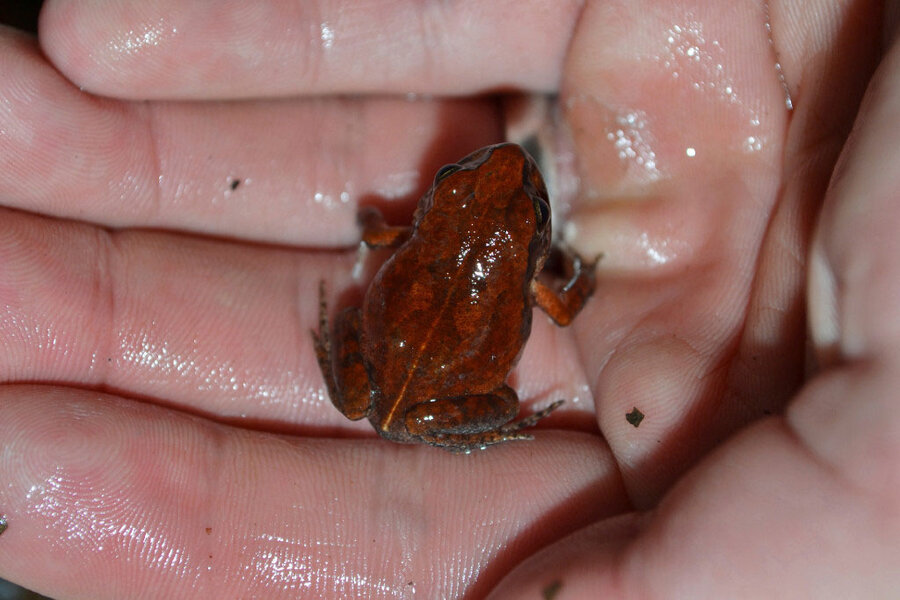After 54 years, how Zimbabwe's 'cave squeaker' frog was re-discovered
Loading...
Arthroleptis troglodytes can rest comfortably on two fingers of your hand. Dark-red and covered in mucus, this frog, better known as the “cave squeaker,” isn’t as photogenic as some of the other fauna in southern Africa.
Nonetheless, its recent rediscovery after 54 years in hiding gave scientists and conservationists reason to celebrate. This past December, a team of Zimbabwean and South African researchers went looking for the frog high in Zimbabwe’s Chimanimani Mountains, where it had last been sighted in 1962.
“I am able to state that this species is alive and well on the summit of Chimanimani,” Robert Hopkins, a research associate at the Natural History Museum in Bulawayo, Zimbabwe, wrote in his research report.
The re-discovery came six years after scientists around the world, seriously concerned about the future of amphibians, began a coordinated search for frogs and salamanders not seen in at least a decade. The rediscovery of the “cave squeaker” is a sign of ongoing progress in this effort.
“These sorts of things are always good news, because there’s so much bad news in the realm of amphibians right now,” Joe Mendelson, director of research at Zoo Atlanta, tells The Christian Science Monitor in a phone interview.
Because they’re exposed to both land and water, amphibians are considered gauges of an ecosystem’s overall health. In recent decades, they’ve shown worrying trends.
The Global Amphibian Assessment, completed in 2004, reported that “at least 1,856 species are considered threatened with extinction, representing 32 percent of all amphibian species. By comparison, 12 percent of birds and 23 percent of mammals are threatened.”
The exact numbers have changed since then, but according to the International Union for the Conservation of Nature and Natural Resources (IUCN), “the global overview provided by the 2004 assessment remains relevant.”
Before experts can recommend appropriate conservation measures, they need to know which species are left. To this end, in 2010 Conservation International and the IUCN launched "The Search for Lost Frogs," a six-month, 19-country search for threatened amphibian species not seen in over a decade.
The first results were disappointing. In February 2011, Conservation International reported that “Only four of 100 missing amphibians that scientists set out to find were located. Eleven more rediscoveries were unexpected surprises.”
Even so, scientists felt compelled to keep looking. According to the Amphibian Survival Alliance and the Amphibian Specialist Group, “the campaign ... garnered such attention that it has inspired the development of a dynamic portal devoted to the ongoing search for ‘lost’ frogs.”
Amphibian experts discussed their next steps at a 2015 meeting of herpetologists in Cape Town, where Dr. Hopkins made his case for the cave squeaker.
At the meeting, he later recalled, “it was prioritized as one of the top ten southern African species in need of conservation research … and its rediscovery must be considered as a high priority … This decision was based on my input. I had said that I had been looking for this species since 1998, without success, but wanted to try again at the end of 2016. This was agreed.”
With support from the Mohamed bin Zayed conservation fund, Hopkins and his team resumed their search in Zimbabwe’s Chimanimani National Park. On December 2nd, one of the team’s members, South African student Francois Becker, called Hopkins to report a sighting of the frog.
The significance of rediscoveries like these “is not always abundantly clear,” Dr. Mendelson says. When a species re-emerges after several decades, it’s hard to tell whether it has “fully recovered back to its normal historical density, or if you have found a few isolated individuals who are hanging on or reproducing at very low levels," he explains.
"Those are two very different phenomena, and when you first find [a species], you really can’t distinguish them."
The cave squeaker’s re-discovery doesn’t erase the threats it faces. The patch of the Chimanimani Mountains where it lives is protected. But last month, African media reported outbreaks of armyworm and black fungus – possibly worsened by climate change – in the region.
These problems could make themselves felt in the high-altitude alcoves where the cave squeaker makes its home. Despite these risks, Hopkins wants to keep the frog in Zimbabwe. “My greatest concern now is that the scientific world will flood in to capture and illegally export specimens from Chimanimani, and I ask the National Parks to be vigilant to this threat,” he wrote in his report.
For his part, Zoo Atlanta’s Dr. Mendelson believes that "there is new knowledge to be gained" by studying the frog in labs, and that "respectable scientists don’t smuggle frogs."
"But at a broader level," Mendelson agrees, "his worries are justified. There’s plenty of evidence of discovered and rediscovered species being pillaged by the pet trade and illegally smuggled."
While the cave squeaker may not be arriving in Atlanta anytime soon, Mendelson considers it a good day for herpetology.
“I’m just happy to hear some good news from the amphibian world," he tells the Monitor. "It doesn’t happen very often."
He adds, "Good on his team! It sounds like they did good work, and their plan to protect it from any and all threats moving forward is fantastic."






